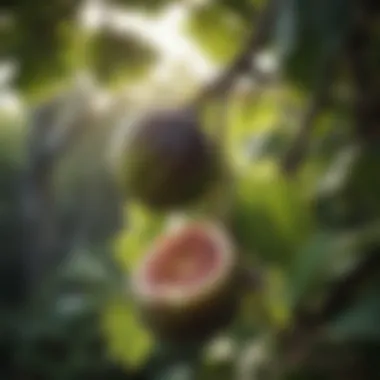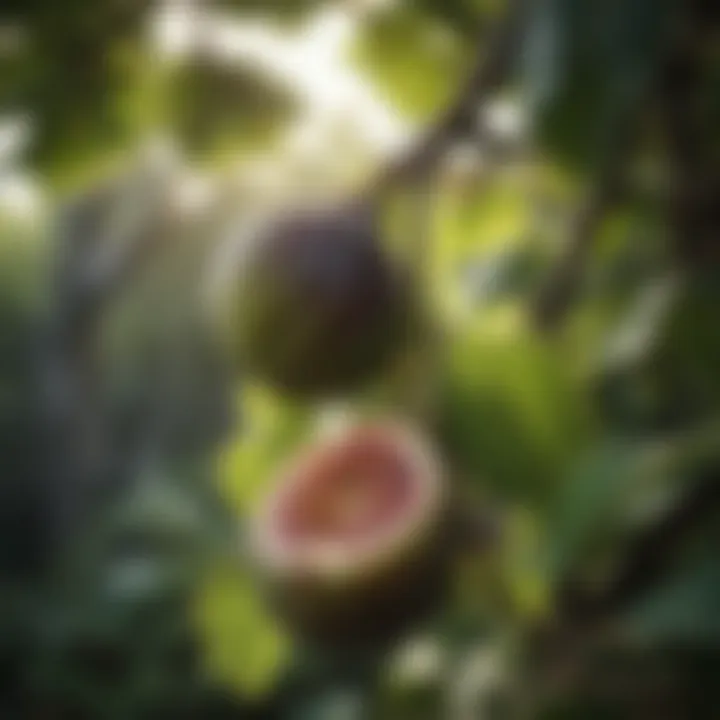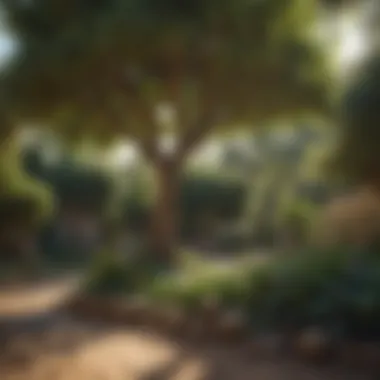Aesthetic and Practical Aspects of Fig Tree Pictures


Intro
Fig trees possess a certain elegance that can captivate anyone. They often evoke feelings of warmth and nostalgia. This article explores the significance of fig tree pictures in various contexts, especially in home decor and gardening. From their aesthetic value to practical applications, the following sections will provide a structured examination of why fig tree imagery is valued.
Photography captures the essence of fig trees. The unique shapes and lush leaves provide a beautiful subject. When incorporated into home design, these images inspire a natural theme that promotes serenity. Homeowners and art enthusiasts alike appreciate how fig trees can enhance their living spaces.
Design Inspiration
Trending Styles
In recent years, there has been a noticeable trend towards nature-themed decor. Fig trees fit perfectly into this style. Incorporating fig tree images can elevate spaces while connecting them with the natural surroundings.
- Minimalistic Design: A simple approach often highlights the beauty of the fig tree without distraction.
- Eclectic Decor: Here, fig tree images can serve as focal points among diverse design elements.
- Bohemian Style: Mixing textures and colors, fig pictures blend seamlessly into boho environments.
Color Palettes
The colors found in fig tree images can resonate with various design themes. Here are some common palettes:
- Earthy Greens: These shades evoke freshness and calmness.
- Warm Browns: Shades reminiscent of the tree trunk, adding warmth.
- Bright Figs: Deep purples or vibrant greens of the fruit bring energy and focus.
Integrating these colors into your space can create a cohesive atmosphere that reflects nature's beauty.
“Nature holds the secret to our aesthetic appreciation; fig trees are a perfect example of this.”
Practical Tips
Maintenance & Care
When considering fig tree pictures for interiors, it's helpful to understand their care needs. For those with real fig trees, proper care is essential. Here are some tips:
- Plant in well-draining soil.
- Water regularly, but do not overwater; allow soil to dry slightly between watering.
- Keep in sunlight, but protect from harsh afternoon rays.
Budgeting & Planning
Creating a space that features fig tree imagery can be affordable with planning. Consider these pointers:
- Decide if you want original art or prints.
- Evaluate local art fairs or online marketplaces for unique finds.
- Budget for frames to enhance your artwork—this can elevate presentation without high costs.
Considering these aspects ensures your space reflects thoughtful design choices with fig tree pictures.
Prelims to Fig Trees
Fig trees hold a prominent position in both agricultural and cultural domains. Their long history of cultivation connects them intimately with human civilization. In this section, we will outline key elements that highlight the importance of fig trees.
The fig tree, primarily known for its edible fruit, has significant contributions to various ecosystems. These trees are not only sources of food but also provide immense aesthetic value. They can be beautiful additions to gardens or landscape designs, often becoming focal points due to their broad leaves and innovative structures.
Understanding the introduction of fig trees provides homeowners, interior design enthusiasts, and gardening aficionados with insights into their benefits. For one, fig trees thrive in diverse climates, making them adaptable to many growing conditions. Furthermore, they require relatively low maintenance, which appeals to busy individuals looking to enhance their spaces without significant effort.
Historical Importance of Fig Trees
The fig tree has been cultivated for thousands of years, making it one of the oldest cultivated plants. Historical texts from ancient civilizations often mention fig trees, showcasing their value. In places like Mesopotamia, evidence of fig cultivation dates back to at least 4000 BC.
The fruit of the fig tree has been significant in many cultures, serving as sustenance as well as a trade good. Figs were mentioned in religious texts, connecting them to spiritual practices. For example, in the Bible, figs symbolize prosperity and abundance, highlighting their cultural significance.
Symbolism of Fig Trees in Culture
Fig trees hold multifaceted symbolism across different cultures. In many societies, they represent fertility, peace, and prosperity. This cultural resonance has made fig trees a preferred subject in art and literature.


In Mediterranean cultures, figs are often seen as symbols of prosperity. In Asian traditions, they symbolize benevolence, often closely associated with Buddha.
"The fig tree transcends its role as just a fruit-bearing plant; it is a symbol that has governed various cultural interpretations."
Through these historical and cultural lenses, one can appreciate the complex relationships individuals have developed with fig trees, which elevate them beyond mere cultivation to elements of identity and existence.
Understanding Fig Tree Varieties
Fig trees belong to the Moraceae family and are native to the Mediterranean region. Understanding fig tree varieties is essential for anyone interested in cultivating these trees, whether for ornamental purposes or for producing fruit. Knowledge of different varieties impacts gardening practices, including appropriate care, pest resistance, and the ability to select types that thrive in specific climates.
Recognizing the unique characteristics and growth habits of various fig tree types ensures that gardeners can make informed choices. Additionally, this knowledge helps in designing attractive landscaping features that incorporate fig trees effectively. In a landscape, figuring out the right variety leads to a more substantial visual appeal while offering benefits like shade, privacy, and the ability to attract wildlife.
Common Varieties of Fig Trees
Here are some of the most common fig tree varieties:
- Common Fig (Ficus carica): This variety is the most widely cultivated for its delicious, edible fruit. It is adaptable and can grow in a range of climates, though it thrives in warm temperatures.
- Black Mission Fig: Known for its dark purple skin and sweet flavor, this variety is commonly found in markets. It also has a high ornamental value due to its attractive foliage.
- Kadota Fig: This green-skinned variety produces a milder flavor and has a standout creamy texture, often used in preserving.
- Brown Turkey Fig: Another popular option, known for its sweet taste and adaptability, making it suitable for various gardening contexts.
- Celeste Fig: This variety is favored for its sweet, rich flavor and is often grown in colder areas because of its cold hardiness.
Each of these varieties has specific care requirements and growth habits, which can affect their viability in different settings.
Unique Characteristics of Specific Varieties
Each fig tree variety comes with its distinct attributes:
- The Common Fig grows up to 30 feet tall and has broad leaves. It is notable for producing two crops annually, sweetening the home garden throughout the season.
- Black Mission Figs yield a second harvest but are more suited for warmer climates, making them prolific in areas with prolonged warm seasons.
- The Kadota Fig stands out due to its slightly thicker skin and is often less susceptible to pests, making it easier to maintain.
- Brown Turkey Fig can bear fruit continuously during the growing season, showing resilience and adaptability across different environmental conditions.
- Celeste Fig is especially prized for its cold tolerance, allowing gardeners in cooler zones to enjoy figs that others cannot.
Understanding these characteristics is vital. Knowing a tree's strengths and requirements aids gardeners in selecting the proper variety for their specific needs. It reduces the risk of disappointing outcomes and fosters a productive gardening experience.
The Art of Fig Tree Photography
Fig tree photography is a unique and profound way to capture not just an object, but the essence of nature and its tranquillity. These trees, with their lush leaves and rich fruits, present an opportunity for photographers to merge artistry with the beauty of horticulture. The images created can serve various purposes, from enhancing one's home décor to providing a visual narrative in nature photography.
When discussing fig tree pictures, it is essential to consider elements such as techniques, lighting, and composition. Each of these aspects plays an integral role in making the final image resonate with its audience. Mastering photography involves understanding how these components work together to highlight the specific characteristics of fig trees, thus making it an essential topic in this article.
Techniques for Capturing Fig Trees
Capturing fig trees involves several techniques that help highlight their unique features. Start with understanding the subject. Fig trees can express their beauty through different stages of growth, so document them throughout the seasons. This variability allows artists to tell a story of life through images.
Here are some key techniques to consider:
- Use a tripod: Stability ensures clarity, especially in low light conditions.
- Focus on details: Zoom in on the textures of the bark and leaves. This emphasizes the tree's character.
- Experiment with angles: Shooting from various angles can create dynamic compositions. Try shooting from below to capture the canopy or from above to showcase the sprawling branches.
Choosing the Right Lighting
Lighting is perhaps the most significant factor in fig tree photography. Natural light, especially soft morning or evening light, enhances the colors and textures of the tree. Harsh midday sun can cast unflattering shadows and bleach out colors, so timing is crucial.
- Golden hour: The period just after sunrise or before sunset provides warm, inviting light.
- Backlighting: Position the sun behind the tree to illuminate the leaves, creating a glowing effect. This technique can add a magical quality to your photos.
Always pay attention to how light interacts with your subject. The right light can transform a straightforward image into a stunning work of art.
Composition Basics for Fig Tree Pictures
Composition is the backbone of any good photograph, including fig tree images. A well-composed photo draws the viewer's eye and conveys the intended message beautifully.
Consider these composition principles:
- Rule of thirds: Place points of interest along the intersections or lines of an imaginary grid. This will create balance and guide the viewer's attention.
- Leading lines: Use branches or pathways that lead the viewer's eye to the subject.
- Negative space: Allow some empty space in the frame to emphasize the tree itself. This can create a feeling of tranquility or isolation, depending on your vision.
Utilizing these composition basics will contribute significantly to the overall impact of your fig tree pictures, making them not just visually appealing but thoughtful representations of nature.


"Good photography is based on good composition. Fig trees provide a rich canvas, and understanding how to frame them is essential for any photographer."
Through a blend of proper techniques, lighting choices, and composition skills, fig tree photography can capture the beauty and essence of nature, appealing to a wide audience from homeowners to gardening enthusiasts.
Incorporating Fig Tree Imagery in Interior Design
Incorporating fig tree imagery into interior design offers a unique way to bring nature inside. Fig trees, with their distinct shape and lush foliage, create a sense of calm and serenity. This can enhance any living space, making it feel more inviting and fresh. As homeowners, interior design enthusiasts, or party hosts consider their decoration themes, fig trees become an attractive option because of their symbolism and aesthetic appeal.
Creating Visual Focal Points
When designing a room, having a focal point is vital. Fig tree pictures can serve as stunning visual focal points. They draw the eye and invite conversation. A large canvas or framed photograph of a fig tree can anchor a room. Placing it above a sofa or mantle can create balance.
Moreover, fig trees symbolize peace and abundance. This meaning adds extra depth to the decor. Using fig tree art can also connect the indoor environment with the natural world. Homeowners should consider:
- The size of the artwork relative to the space
- Color harmony with existing decor
- The overall theme of the interior space
Utilizing Fig Tree Art in Different Spaces
Fig tree art fits well in various settings. In a living room, it can be a beautiful centerpiece. In a dining area, it can enhance the atmosphere during meals. Even in home offices, fig imagery can create an inspiring workspace. Think about where the art is placed:
- Living Rooms: Large pieces can serve as statement art.
- Kitchens: Smaller fig prints can add charm and warmth.
- Bathrooms: Fig tree images can evoke a spa-like feeling.
Additionally, fig tree images can work well in both traditional and modern design styles. The versatility of these images makes them suitable for many interior themes.
Choosing the Right Frames and Backdrops
Selecting frames and backdrops for fig tree pictures is essential. The frame should complement the artwork without overpowering it. Neutral or natural wood frames can enhance the organic feel of the fig tree image.
Backdrops also play a critical role. The wall color should not clash with the colors in the art. Light and muted tones create a harmonious background. In contrast, bold colors can make the artwork stand out.
Consider these tips:
- Use frames that match or enhance your existing furniture style.
- Place fig art against walls that amplify its beauty without distraction.
- Think about the lighting. Soft, warm light can highlight the textures in the fig tree imagery.
In summary, fig tree imagery has great significance in interior design. It can create focal points, fit various spaces, and needs careful consideration in framing and backgrounds. By utilizing these techniques, homeowners can transform their interiors and invite nature's beauty into their living spaces.
The Significance of Fig Trees in Gardening
Fig trees hold immense value in gardening, offering both aesthetic and practical benefits. These trees are known for their lush foliage and attractive shape, making them a great addition to any garden. The broader significance of fig trees extends beyond mere appearance, encapsulating environmental advantages, culinary uses, and the joy of nurturing a fruitful plant. This section explores these various elements in detail, emphasizing the role of fig trees in enriching the garden experience.
Caring for Fig Trees
Caring for fig trees requires attention and proper cultivation methods. Fig trees thrive in well-drained soil and prefer a sunny position, ideally receiving full sunlight for at least six hours daily. Regular watering is essential, especially during dry spells, but it is important to avoid waterlogging, which can harm the roots.
Pruning is another vital aspect of fig tree care. It helps maintain the tree's shape and promotes better air circulation, reducing the risk of disease. Ideal timing for pruning is during the dormant season in late winter. Fertilization should occur primarily in spring, using a balanced fertiliser that supports growth.
"Healthy fig trees produce abundant fruit, rewarding careful gardeners with both beauty and sustenance."
Fig Trees as Part of Sustainable Gardening
Incorporating fig trees into sustainable gardening practices is increasingly popular. Their ability to adapt to various climates enhances biodiversity in the garden ecosystem. Fig trees are also drought-tolerant once established, meaning they require less water compared to other fruit-bearing plants.
The role of fig trees in attracting pollinators cannot be overstated. These trees serve as an important food source for bees and other pollinators, contributing to a balanced ecological system. Growing fig trees can even reduce the need for chemical pesticides, as their hardiness and resilience often mean they are less susceptible to pests.
Common Pests and Diseases Affecting Fig Trees
Despite their robustness, fig trees can face various pests and diseases. Common pests include fig beetles, aphids, and spider mites. These insects can affect the health of the trees if not managed promptly. Regular inspection is key; noticing these pests early can prevent larger infestations.
Fig trees are also prone to diseases such as fig rust and bacterial blight. Recognizing the signs, like discoloration of the leaves or fruit drop, is essential for timely treatment. Organic solutions, including neem oil or insecticidal soap, can often manage these issues effectively without harmful side effects.


In summary, the significance of fig trees in gardening lies in their ability to provide beauty, improve sustainability, and yield delectable fruit. Proper care, sustainable practices, and knowledge of potential threats all contribute to a successful fig tree experience.
The Role of Fig Trees in Culinary Practices
Fig trees hold a significant place in culinary practices worldwide. Their fruits, known for their unique flavor and texture, bring both sweetness and a nutrient-rich addition to various dishes. Figs can be consumed fresh, dried, or cooked, making them incredibly versatile in kitchens. This section explores the different edible varieties of figs and their culinary applications.
Edible Varieties and Their Uses
Figs come in several varieties, each offering distinct flavors and textures. Some notable edible figs include:
- Black Mission: These figs are small to medium in size with a dark purple to black skin. They have a rich flavor, making them perfect for desserts or paired with cheese.
- Calimyrna: Recognized for their slightly teardrop shape, these figs are golden yellow and contain a nutty flavor. They are often used in Mediterranean dishes and dried snacks.
- Kadota: These green figs are notably sweet but have a denser flesh. They work well in salads and as toppings on pizzas or flatbreads.
Benefits of using figs in cooking:
- Nutritional Value: Figs are rich in fiber, antioxidants, and essential minerals like potassium and magnesium.
- Natural Sweetener: Their sweetness can reduce the need for added sugars in recipes, which is beneficial for health-conscious individuals.
- Culinary Diversity: Figs can be integrated into both savory and sweet dishes, ranging from salads to desserts.
Incorporating Figs in Modern Cuisine
Modern cuisine embraces figs due to their unique characteristics. Chefs and home cooks alike enjoy experimenting with figs in various ways. Here are some approaches to incorporating figs in dishes:
- Salads: Fresh figs can add sweetness and texture to salads. Combining them with goat cheese and arugula creates a delightful contrast.
- Charcuterie Boards: Dried figs serve as an excellent component on charcuterie boards, paired with meats and cheeses.
- Baking: Figs can enhance bread and muffin recipes. Incorporating chopped figs adds moisture and a natural sweetness.
- Sauces and Reductions: Cooking figs down into a sauce can amplify flavors in meats, particularly using them with pork or poultry.
Figs not only elevate the aesthetic of a dish, but they also enrich the flavor profile, making them a staple for culinary enthusiasts.
Understanding how to use figs can add depth to your cooking repertoire. Their health benefits, combined with versatility, make them a valuable asset in any kitchen.
The Environmental Impact of Fig Trees
The examination of fig trees' environmental impact uncovers their vital role in promoting biodiversity and enhancing ecosystems. An understanding of these contributions is essential for appreciating their significance beyond ornamental appeal. This section explores how fig trees serve as a foundation for ecological balance and their ability to adapt to changing climatic conditions.
Biodiversity and Ecosystem Contributions
Fig trees are instrumental in maintaining biodiversity within their habitats. They produce a unique fruit that attracts various species, including birds, insects, and mammals. The presence of fig trees can create a habitat that supports an entire food web. Many animals rely on the fig as a food source, especially during dry months when other food is scarce.
The dense foliage of fig trees provides shelter and nesting sites for birds and small organisms. As the Ficus genus has a wide geographical distribution, fig trees enhance the resilience of local flora and fauna against environmental stressors. This biodiversity is crucial for ecosystem health, as it promotes pollination and seed dispersal, two key processes that sustain other plant populations.
Moreover, fig trees have a symbiotic relationship with specific wasp species. Each fig tree is associated with a particular wasp species that pollinates them. This unique interaction highlights the interconnectedness of species and emphasizes the importance of conserving fig ecosystems.
"The relationships formed in fig ecosystems demonstrate the intricate balance of life, showcasing the essential roles species play in sustaining their environments."
Climate Adaptation of Fig Trees
Fig trees exhibit remarkable adaptability to different climatic conditions. They thrive in a range of environments, from tropical to Mediterranean climates. This flexibility ensures that they can grow in diverse regions, contributing to their widespread presence.
The ability of fig trees to withstand drought is noteworthy. Their extensive root systems allow them to access deeper soil moisture, which is vital during dry periods. This capability makes them suitable for cultivation in areas with limited water resources, offering potential solutions for sustainable agriculture.
Furthermore, fig trees can help mitigate climate change effects. By absorbing carbon dioxide, they contribute to reducing greenhouse gases in the atmosphere. The shade provided by these trees also helps in regulating local temperatures, creating cooler microclimates. Their role in soil stabilization prevents erosion, preserving the land's integrity and promoting healthier ecosystems.
In summary, the environmental impact of fig trees cannot be overstated. They enrich biodiversity, support various species, and adapt to climate changes, making them invaluable components of ecosystems. Homeowners and gardening enthusiasts should regard fig trees not only as an addition to their gardens but also as a commitment to fostering ecological health. By promoting the growth of fig trees, individuals contribute positively to their local environments.
Ending
The conclusion plays a significant role in synthesizing the wealth of information discussed within this article. Fig trees are not merely aesthetic elements; they represent deeper cultural and historical values. Their imagery captures attention and invokes feelings, making them important in various contexts, such as photography and interior design. The visual appeal of fig trees enhances spaces, bridging the gap between nature and modern decor.
Reflecting on the Importance of Fig Trees
Fig trees are also notable for their contributions to biodiversity. They offer food and shelter to various species, promoting ecological balance. This environmental significance cannot be overlooked. Understanding this importance allows homeowners and gardening enthusiasts to appreciate fig trees as living art forms rather than just ornamental plants. Their role in sustainable gardening practices is also worth noting. Fig trees require less water compared to other fruit-bearing trees, which makes them suitable for regions facing water scarcity.
Additionally, their adaptability to different climates makes them a resilient choice in horticulture. For interior design enthusiasts, the artistic representation of fig trees in photographs can transform spaces. The variety of shapes, colors, and textures found in fig trees can complement various design styles, from minimalist to bohemian.
Future Trends in Fig Tree Photography and Usage
As we move forward, there are emerging trends in fig tree imagery. The rise of social media platforms like Instagram has increased the demand for striking, visually appealing content. Photographers are increasingly focused on capturing the intricate details of fig leaves and the unique shapes of the branches. Additionally, there is a growing interest in organic and sustainable food practices. As more individuals turn to home gardening, there's potential for fig trees to gain a more prominent place in backyard settings and community gardens.
Moreover, technology is evolving with the advent of high-quality smartphones. This advancement enables more people to capture beautiful fig tree photos without needing professional equipment. Creativity in the presentation of fig tree imagery is likely to flourish, from incorporating natural light in outdoor settings to experimenting with indoor arrangements.















